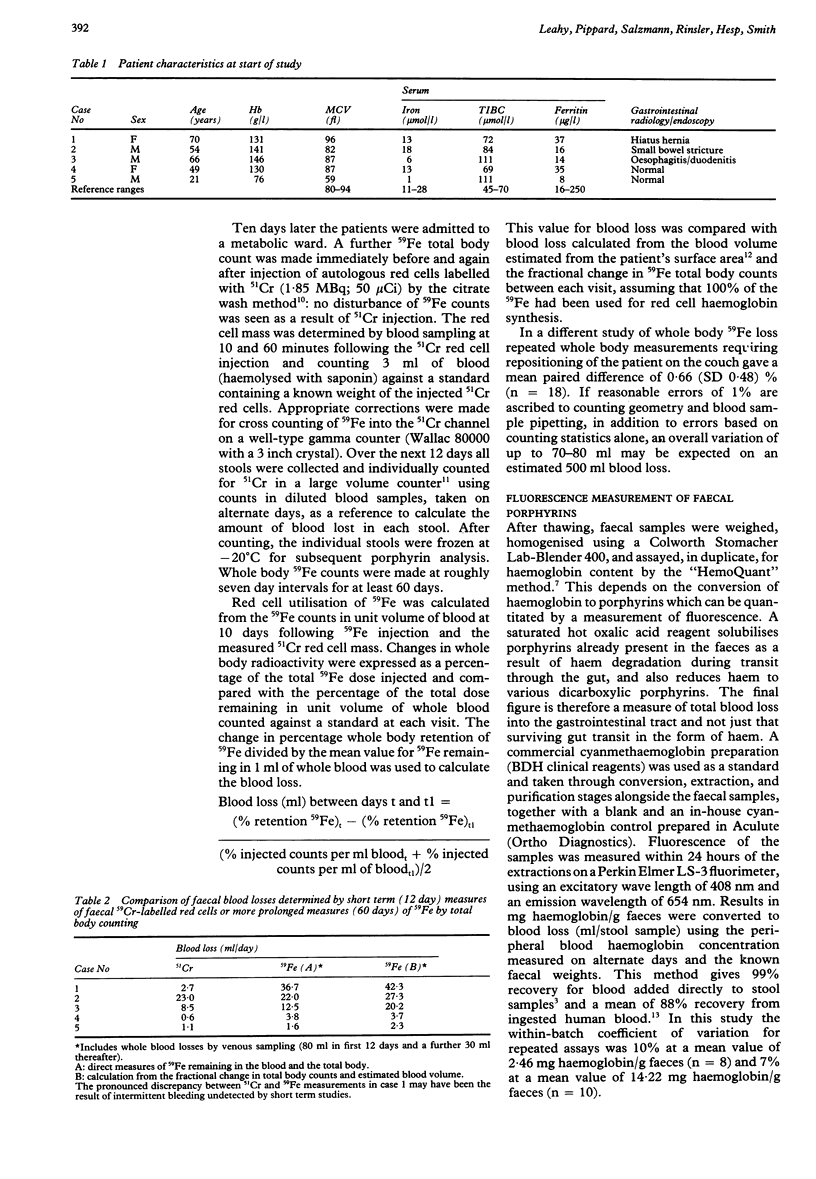Abstract
Blood loss in faeces was assessed by three different methods in five patients with recurrent iron deficiency. In short term (12 day) studies chemical analysis of complete stool collections for haemderived porphyrins (HemoQuant) gave results closely correlated with those obtained by measuring stool loss of 51Cr-labelled red blood cells. Whole body counting for 59Fe was relatively insensitive to small blood losses but allowed losses to be followed up over longer periods. Chemical analysis of faecal porphyrins thus provides a satisfactory alternative to radioisotopic techniques in short term quantitation of faecal blood loss, while longer term whole body counting of 59Fe may still be appropriate in a few patients for the detection and quantification of intermittent blood losses.
Full text
PDF



Selected References
These references are in PubMed. This may not be the complete list of references from this article.
- Ahlquist D. A., McGill D. B., Schwartz S., Taylor W. F., Ellefson M., Owen R. A. HemoQuant, a new quantitative assay for fecal hemoglobin. Comparison with Hemoccult. Ann Intern Med. 1984 Sep;101(3):297–302. doi: 10.7326/0003-4819-101-3-297. [DOI] [PubMed] [Google Scholar]
- Ahlquist D. A., McGill D. B., Schwartz S., Taylor W. F., Owen R. A. Fecal blood levels in health and disease. A study using HemoQuant. N Engl J Med. 1985 May 30;312(22):1422–1428. doi: 10.1056/NEJM198505303122204. [DOI] [PubMed] [Google Scholar]
- BANNERMAN R. M. Measurement of gastro-intestinal bleeding using radioactive chromium. Br Med J. 1957 Nov 2;2(5052):1032–1034. doi: 10.1136/bmj.2.5052.1032. [DOI] [PMC free article] [PubMed] [Google Scholar]
- Cronquist A. G., Mackenzie J., Smith T. A high resolution bulk-sample counter with variable geometry. Int J Appl Radiat Isot. 1975 Feb;26(2):89–91. doi: 10.1016/0020-708x(75)90108-8. [DOI] [PubMed] [Google Scholar]
- Feinberg E. J., Steinberg W. M., Banks B. L., Henry J. P. How long to abstain from eating red meat before fecal occult blood tests. Ann Intern Med. 1990 Sep 1;113(5):403–404. doi: 10.7326/0003-4819-113-5-403. [DOI] [PubMed] [Google Scholar]
- Holt J. M., Mayet F. G., Warner G. T., Callender S. T. Measurement of blood loss by means of a whole-body counter. Br Med J. 1967 Oct 14;4(5571):86–88. doi: 10.1136/bmj.4.5571.86. [DOI] [PMC free article] [PubMed] [Google Scholar]
- IRONS G. V., Jr, KIRSNER J. B. ROUTINE CHEMICAL TESTS OF THE STOOL FOR OCCULT BLOOD: AN EVALUATION. Am J Med Sci. 1965 Mar;249:247–260. doi: 10.1097/00000441-196503000-00001. [DOI] [PubMed] [Google Scholar]
- Raffin S. B., Woo C. H., Roost K. T., Price D. C., Schmid R. Intestinal absorption of hemoglobin iron-heme cleavage by mucosal heme oxygenase. J Clin Invest. 1974 Dec;54(6):1344–1352. doi: 10.1172/JCI107881. [DOI] [PMC free article] [PubMed] [Google Scholar]
- Retzlaff J. A., Tauxe W. N., Kiely J. M., Stroebel C. F. Erythrocyte volume, plasma volume, and lean body mass in adult men and women. Blood. 1969 May;33(5):649–661. [PubMed] [Google Scholar]
- Robertson J. D., Maughan R. J., Davidson R. J. Correlation between qualitative and quantitative faecal occult blood tests. Clin Chim Acta. 1987 Dec;170(2-3):339–343. doi: 10.1016/0009-8981(87)90145-8. [DOI] [PubMed] [Google Scholar]
- Rose I. S., Young G. P., St John D. J., Deacon M. C., Blake D., Henderson R. W. Effect of ingestion of hemoproteins on fecal excretion of hemes and porphyrins. Clin Chem. 1989 Dec;35(12):2290–2296. [PubMed] [Google Scholar]
- Rose I. S., Young G. P., St John D. J., Deacon M. C., Blake D., Henderson R. W. Effect of ingestion of hemoproteins on fecal excretion of hemes and porphyrins. Clin Chem. 1989 Dec;35(12):2290–2296. [PubMed] [Google Scholar]
- Schwartz S., Dahl J., Ellefson M., Ahlquist D. The "HemoQuant" test: a specific and quantitative determination of heme (hemoglobin) in feces and other materials. Clin Chem. 1983 Dec;29(12):2061–2067. [PubMed] [Google Scholar]
- Schwartz S., Ellefson M. Quantitative fecal recovery of ingested hemoglobin-heme in blood: comparisons by HemoQuant assay with ingested meat and fish. Gastroenterology. 1985 Jul;89(1):19–26. doi: 10.1016/0016-5085(85)90740-1. [DOI] [PubMed] [Google Scholar]
- Simon J. B. Occult blood screening for colorectal carcinoma: a critical review. Gastroenterology. 1985 Mar;88(3):820–837. doi: 10.1016/0016-5085(85)90158-1. [DOI] [PubMed] [Google Scholar]
- Smith T., Hesp R., Mackenzie J. Total body potassium calibrations for normal and obese subjects in two types of whole body counter. Phys Med Biol. 1979 Jan;24(1):171–175. doi: 10.1088/0031-9155/24/1/016. [DOI] [PubMed] [Google Scholar]
- Stack B. H., Smith T., Jones J. H., Fletcher J. Measurement of blood and iron loss in colitis with a whole-body counter. Gut. 1969 Oct;10(10):769–773. doi: 10.1136/gut.10.10.769. [DOI] [PMC free article] [PubMed] [Google Scholar]


